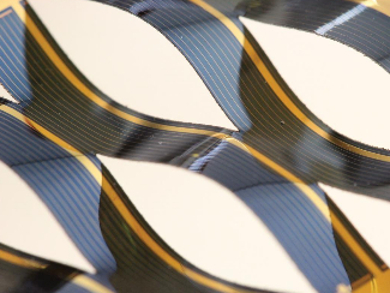Optical trackers that reorient solar cells during the day are often complex and expensive, and they require heavy support structures. Stephen Forrest and colleagues at the University of Michigan, Ann Arbor, USA, produced a new type of solar cell using techniques borrowed from the art of kirigami (paper cutting).
The team stretched Kapton (a polyimide film) sheets, patterned with arrays of parallel slits to produce tilted surface elements. Varying the amount of stretching provided precise control over the tilt angles of the thin strips between the slits. The researchers then mounted thin, flexible gallium arsenide photovoltaic cells to the Kapton sheets using a gold film adhesive. A top coating of titanium oxide and magnesium fluoride reduced reflection losses at oblique angles.
The output energy density for an optimized kirigami system approaches that of conventional single-axis tracking mechanisms when the slits are long relative to the spacing between them, a remarkable feat for solar cells that do not change their macroscopic orientation.
These structures performed electrically and mechanically for more than 300 cycles. Fabrication and materials were cost-effective and scalable, and the researchers predict that similar structures could be used for phased array radar and optical beam steering devices.
- Dynamic kirigami structures for integrated solar tracking,
Aaron Lamoureux, Kyusang Lee, Matthew Shlian, Stephen R. Forrest, Max Shtein,
Nat. Commun. 2015, 6, 8092.
DOI: 10.1038/ncomms9092




